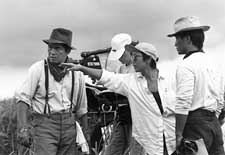 Actors Akira Takayama (left) and Cary-Hiroyuki Tagawa (right) with director Kayo Hatta |
In filmmaking, there is sometimes a magical moment when you forget you are making a movie. All the years of endless grantwriting, fundraising, research, screenwriting, the
frantic weeks of pre-production and finally, the daily battles of production, are momentarily forgotten. For many of us who worked on PICTURE BRIDE, this happened on the first day we shot our canefield scenes in Waialua on O'ahu's North Shore.
![]()
![]()

![]()
Actors Akira Takayama (left) and Cary-Hiroyuki Tagawa (right) with director Kayo Hatta
A hush fell over the set as one by one, the extras began arriving in costume over the crest of the hill, some holding the hands of small children, also dressed in period clothing. It was as if we were watching an old sepia-toned black and white photograph coming to life in vivid colors: the deep blue indigo of the women's work clothing, the pearly white of clouds against blue skies, the lush green of endless acres of canefields, undulating in the morning breeze as they have for over a hundred years.
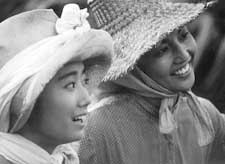 Actors Youki Kudoh (left) and Tamlyn Tomita (right) between scenes |
The vision for PICTURE BRIDE began with voices - women singing hole hole bushi. I still remember the first time I heard them. In 1986 I contacted Harry Urata, a music teacher and ethnomusicologist in Nu'uanu, Honolulu and he sent me an audiocassette of songs sung by retired plantation workers whom he had recorded in the 1960s. These earthy, sometimes bitter or angry, sometimes tender, sentimental, or raucously humorous songs were a revelation - we had our own blues, the Japanese Hawaiian blues - similar to the call-and-response slave songs of the cotton plantations in the old South.
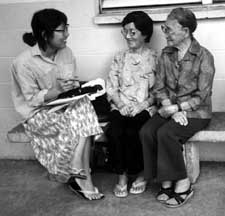 Kayo Hatta (left) interviews picture brides |
In researching and writing the PICTURE BRIDE story, we found that it was precisely the small, seemingly mundane details of daily life - giving birth, raising children, the hardship of daily work - that revealed the lives of our grandmothers and great-grandmothers most intimately. Through these details we come to understand and appreciate who they really were - and ultimately, who we are today. This is what we hoped to accomplish in telling their stories. Indeed, some of most gratifying responses to the film are from the many people who have told us that the film inspired them to find out more about their own family history, and to interview surviving grandparents before it was too late.
 Kana and Riyo search for Kana's baby in a cane fire |
One of the most vital collaborations during the research and writing stage was with local historian and writer Barbara Kawakami. Barbara, who had been doing years of research for her book on Japanese immigrant clothing in Hawai'i, facilitated my own efforts to do the primary research of interviewing actual picture brides. She helped me locate the few surviving brides and often accompanied me on interviews. The oral history process is a long and arduous one, requiring time and patience to develop rapport with one's subjects. But Barbara had already gained the trust of her interviewees, and they felt comfortable in speaking openly and intimately with me about their experiences.
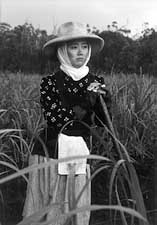 Riyo confronts the harsh realities of plantation life |
Perhaps the turning point came in 1991, late one afternoon in the middle of the Waialua canefields. In PICTURE BRIDE, the characters' lives are intrinsically connected to the land and the landscape was becoming more and more of a character in our screenwriting. Wanting to immerse myself as much as possible in that environment, I would often drive out to Waialua from Honolulu. There I had a favorite place to think and write: a tiny, neglected graveyard in the middle of the canefields where Japanese and Portuguese cane workers had been buried. On this afternoon, I had brought along the cassette tape of the hole hole bushi songs. As the sun set, the evening winds picked up and blew through the silhouetted canefields, and I got "chicken skin" hearing the ghostly whispering sound accompanying the old songs. It was then that I realized that in order to create a compelling narrative and move the story beyond docu-drama, it would have to dramatize the strongly spiritual aspect of Hawai'i.
 Matsuji and Riyo picnic in the 'real paradise' |
Historically, as in modern life today, folk beliefs and superstitions existed alongside traditional religions such as Buddhism or Christianity. Formal religious institutions were especially important to immigrants, giving them not only a sense of spiritual continuity from the old world, but social cohesion and structure in their new world. With the advent of picture brides, communities flourished and plantation workers were finally able to start families, thus necessitating social institutions such as schools and churches.
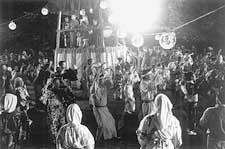 Plantation workers gather for a bon odori |
Balancing authenticity with the need to reach a broad audience also informed some other aesthetic choices in the film. For instance, we wanted the characters to speak in plantation Pidgin, but if we had them speak exactly the way it was spoken back in 1918, the entire film would have had to be subtitled. Working with Pidgin-language advisors, some debate ensued over linguistic purity and authenticity, but we finally reached what we felt was an acceptable compromise, modifying the Pidgin so the audience would at least get the flavor of the Creole without subtitles.
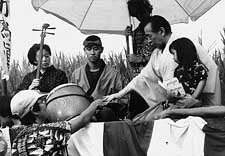 Actor Toshiro Mifune rehearses scene with Kayo Hatta (lower left) |
What we ultimately learned in trying to combine history and fiction was that as long as we stayed true the essential spirit of the stories, we could strike the delicate balance and still tell a good story. PICTURE BRIDE is historically based, but ultimately, it is an artistic interpretation of history. Hopefully, we have succeeded in creating a film that stirs the imagination and leaves some questions unanswered, encouraging viewers to find out more on their own.
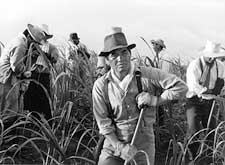 Matsuji (Akira Takayama) reflects on the challenges of marriage |
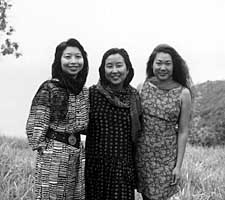 Director/co-writer Kayo Hatta (center) with producers Diane Mark and Lisa Onodera |
Kayo Hatta was born in Mo-'ili'ili, Hawai'i and raised in New York. She graduated from Stanford University with a B.A. in English and from U.C.L. A. with an M.F.A. in film production. Hatta directed and co-wrote PICTURE BRIDE, her first feature film.
Glossary
hole hole bushi: (ho-lei ho-lei boo-shee) songs that Japanese women cane workers sang while at work in the fields. "Hole hole" describes the work of stripping cane leaves from the stalks and was usually done by women. "Bushi" is the Japanese word for song. Though initially sung by women, the songs were later sung by men as well.
yoishare: (yoy-shah-dey) when a "hole hole bushi" was sung by a fellow worker, the other workers responded as a chorus with an encouraging and rousing "yoishare! yoishare!" While there is no real translation of this, a close approximation might be "that's it! keep it going!" hoe hana: the work of weeding the canefields with a hoe. "Hana" is the Hawaiian word for "work." luna: Hawaiian for plantation overseer